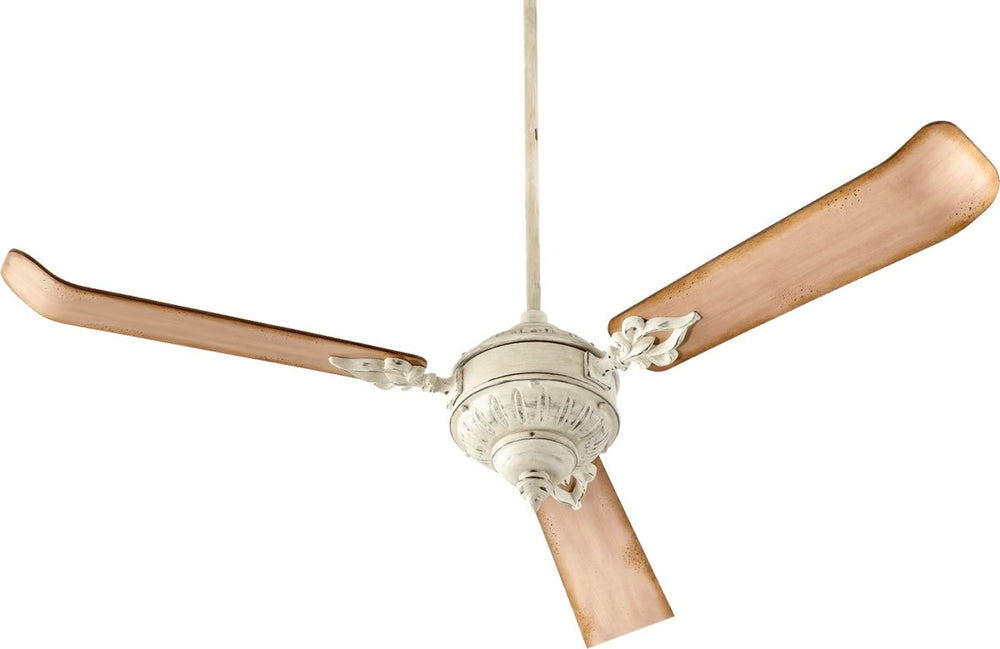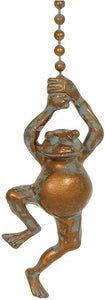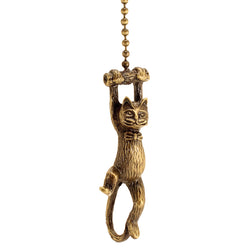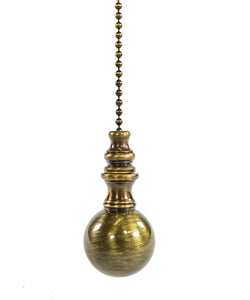Quorum 60"W Brewster Ceiling Fan Persian White

60"W Brewster Ceiling Fan Persian White
This Brewster Ceiling Fan by Quorum features an Persian White finish, that will bring a terrific look to any room.- Persian White
- Features 3 x blades in Weathered Pine Finish
- Arm Pitch: 14
- 17.75'' Height x 60'' Width
- Motor Size: 172x20 mm
- Motor Poles: 16
- Motor Lead Wire: 3.15
- Motor Pull Switch: 7-1092-6 Wall Control
- Downrod: 6" length
- 89 / 65 / 45 / 31 Revolutions per Minute (high / medium / low / extra low)
- 51 / 28 / 16 / 7 Watts of power consumption (high / medium / low)
- .42 / .31 / .23 / .17 amps (high / medium / low)
- Weight: 22.6 lbs
- Part of Brewster Collection
- UL Listed: Dry
- Motor Warranty: Limited Lifetime
| Revolution Speed (RPM - Revolutions per Minute) | Air Flow (CFM - Cubic Feet of Air Flow per Minute) | Electricity (Watts - Electricity used not including any Lights) | Efficiency (CFM/Watt - Cubic Feet of Air Flow per Minute per Watt used - higher is better) | AMPs (Amperage of Electrical Current used) | |
| HIGH Speed | 89 | 4812 | 51 | 94 | 0.42 |
| MEDIUM Speed | 65 | 28 | 0.31 | ||
| LOW Speed | 45 | 16 | 0.23 | ||
| Efficiency is the cubic feet of air that can be moved in one minute if the fan were to use 1 watt of electricity, and can be used to compare energy-efficiency among different ceiling fans. The higher this number the more energy-efficient the fan is. This ceiling fan's airflow efficiency is above average, compared to fans with larger than a 52" blade span. By comparison, other regular-sized ceiling fans with a larger than 52" blade span typically provide an airflow efficiency ranging from 43 to 94 cubic feet per minute per watt. | |||||

What is an Ceiling Fan?
 A ceiling fan is a fairly large ceiling-mounted fan which can rotate clockwise or anticlockwise. In one direction the fan blows air downward, while in the other it draws air upwards. Some fans come equipped with a light fixture to double as a central light. The fan is a hardwired fixtures so has to be installed electrically. Typically it is used with a wall switch or remote control. Ceiling fans can help keep you cool in summer and also warmer in winter by circulating the air.
A ceiling fan is a fairly large ceiling-mounted fan which can rotate clockwise or anticlockwise. In one direction the fan blows air downward, while in the other it draws air upwards. Some fans come equipped with a light fixture to double as a central light. The fan is a hardwired fixtures so has to be installed electrically. Typically it is used with a wall switch or remote control. Ceiling fans can help keep you cool in summer and also warmer in winter by circulating the air.
Ceiling Fan Benefits
- Circulates air for healthier breathing.
- Reversible direction for summer/winter.
- Blows air onto bodies for direct cooling.
- Draws hot air upwards for ambient cooling.
- Optional speeds for varying effect.
- May add to lighting (if light is included or addedd).
- Saves on electrical heating bills.
- Keeps rooms fresher and helps remove odors.
- Provides a gentle breeze over a bed or chair.
- Usually can be manually (pull chain) or wall (switch) operated.
- Helps to remove or distribute hot rising air.
Modern Style
Contemporary and innovative, modern lighting underscores futuristic form and structure, and geometric or asymmetrical shapes. A modern lighting design instills functionality within an artfully streamlined form, radiating a reflective glow while providing clear and bright light. Modern Lighting complements a sleek, contemporary interior with straight lines, and can also create an agreeable contrast with transitional styles.
For which rooms?
A ceiling fan needs enough headroom, so is ideal over some furniture such as a couch, seating area or bed. See hugger fans for maximizing headroom. Fans are most often used in living rooms, family rooms and bedrooms, where people might be dwelling for a longer period of time.
Placement/Layering
A fan is best positioned either centrally in the room or above a main seating or sleeping area. If the fan has a light it can help to light the room. We recommend adding either wall lights or some lamps to fill out the space.
Mounts to the Ceiling
Attaches to a ceiling. The ceiling should be flat, unless the fan supports sloped/vaulted ceilings. A small canopy will conceal the electrical installation.
Installed by an Electrician
An electrician or person with electrical installation knowledge will need to permanently wire the ceiling fan into the building's electrical supply.
Resources
Learn how to choose ceiling fans with our Energy Star lighting
We've shopped for you!
You're getting the the lowest prices, guaranteed!
Thousands of items are on sale every day. Plus you're tax-free unless you live in Wisconsin.
Want a different price? Contact us for a personalized quote.
Safely checkout with our world-class encryption.
Trusted by over 100,000 customers, your private and payment data is secure and will not be shared.
We accept Visa, Mastercard, Discover and Paypal. Credit cards can also be processed through Paypal.
Spend $49.00 to get Free Shipping (contiguous USA).
Most other items ship for $9 in 1-3 business days (contiguous USA). QuickShip items ship out the next business day.
Depending on your location, shipments take on average 3-5 business days or up to 7-10 from coast to coast. We ship from multiple locations.
You will receive tracking numbers by email when your items ship out, via Fedex, UPS or USPS.
You'll be able to track the packages online or on our site.
You can also talk to our team of experts at any time, or Live Chat.
Enjoy 30 days for easy returns. See our return policy for details.
We replace breakages/damages/missing parts etc for free.
Every item is covered under our extended 1-year warranty.





